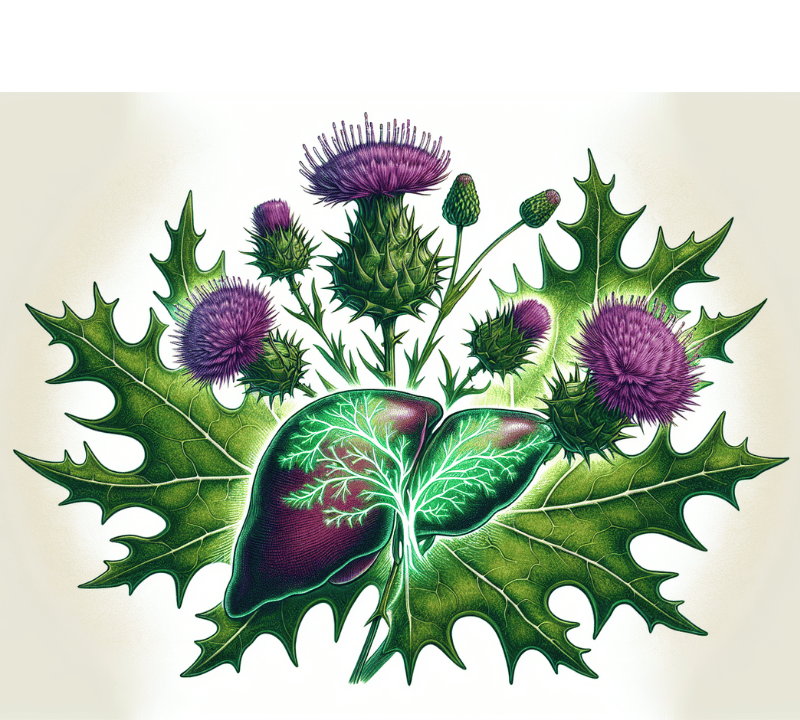Embarking on a journey toward liver recovery with milk thistle unfolds a tale of ancient wisdom melded with modern science. This potent herb, known scientifically as Silybum marianum, has long been revered for its remarkable ability to support healthy liver function. The heart of milk thistle's power lies in its active ingredient, silymarin, a compound lauded for its antioxidant properties, which plays a pivotal role in safeguarding the liver from the ravages of various diseases. Whether you're grappling with the challenges of alcoholic liver disease, nonalcoholic fatty liver disease, or another form of liver disorder, understanding how long it takes milk thistle to weave its restorative magic is essential. With liver health being a paramount concern in an age where chronic liver disease and liver damage are increasingly common, this article dives deep into the scientific evidence, offering a beacon of hope for those seeking to reclaim their vitality.
Yet, the journey of milk thistle from the seed to a potent extract capable of rejuvenating the liver is not a simple tale. It encompasses a complex interplay of dosage, individual health variables, and the severity of liver conditions. The narrative is enriched by studies highlighting its beneficial effects in improving liver function tests and potentially reducing mortality in conditions like cirrhosis. Silymarin’s mechanism of action is multifaceted, involving antioxidant activities, blocking toxic substances at the cellular level, enhancing protein synthesis, and boasting antifibrotic and anti-inflammatory effects. This article not only aims to answer the pivotal question, "How long does it take milk thistle to help your liver?" but also to guide you through the scientific landscapes of randomized controlled trials and clinical evidence, shedding light on the timelines and outcomes you can expect. Whether you are taking milk thistle as a dietary supplement, exploring its potential in randomized clinical pilot studies, or curious about its interaction with conditions ranging from kidney disease to breast cancer, this comprehensive exploration offers a clear vision of milk thistle’s role in liver health, setting the stage for informed decisions and discussions with your healthcare provider.
Key Takeaways
- Milk thistle, primarily due to the active component silymarin, requires time to enhance liver health, and its efficacy varies by dosage, individual health, and severity of liver disease. Studies support its use in various liver conditions, like ALD and NAFLD, by improving liver function and possibly reducing mortality in cirrhosis.
- Silymarin in milk thistle works through antioxidant activities, blocking toxins at the membrane level, enhancing protein synthesis, and antifibrotic and potential anti-inflammatory effects. It supports the liver’s natural healing process and is beneficial across various liver diseases.
- While milk thistle can help improve liver health, evidenced by better liver function test results and decreased symptoms, it has potential interactions with certain medications and conditions. Consulting a healthcare provider is essential before starting treatment to ensure proper dosing and manage interactions.
Unveiling the Timeline for Liver Recovery with Milk Thistle

Since ancient times, milk thistle has been utilized for its potent healing properties, particularly in treating liver diseases such as fatty liver disease, hepatitis, and cirrhosis. This is primarily attributed to silymarin, the active component of milk thistle, known for its antioxidative and anti-fibrotic effects. However, taking milk thistle is not akin to waving a magic wand. Effective liver health improvement requires patience and time for the supplement to work its wonders.
The milk thistle dosage is a critical factor in the timeline of liver recovery. Given the lack of a standard dosage due to variations in supplement quality and active ingredients, it’s best to discuss the appropriate dosage with a healthcare provider. Age and lifestyle can also affect the timeline, emphasizing the need for individualized approaches in supporting liver health.
It’s important to note that the effects of milk thistle have been endorsed in clinical guidelines for managing alcohol-related liver disease (ALD) and non-alcoholic fatty liver disease (NAFLD). This endorsement stems from numerous clinical studies that have demonstrated that patients with liver diseases who use milk thistle show improvements in liver function measurements such as aminotransferases, albumin, malondialdehyde levels, and histologic findings compared to those taking a placebo.
One such study revealed that patients with alcoholic cirrhosis taking milk thistle had a significant reduction in liver-related mortality compared to those taking a placebo. In another placebo-controlled trial, patients with chronic hepatitis C demonstrated a decrease in liver enzymes and improved liver inflammation after taking milk thistle. These studies affirm the beneficial role of milk thistle in liver health and provide a glimpse into the timeline of liver recovery.
In the context of fatty liver disease, both alcoholic and non-alcoholic, milk thistle has shown promising results, and in a clinical trial involving patients with non-alcoholic fatty liver disease, milk thistle supplementation led to improved markers of liver injury and a decrease in liver enzymes, suggesting enhanced liver function. Similar improvements were observed in patients with alcoholic fatty liver disease, indicating the potential of milk thistle in managing a spectrum of liver diseases.
However, the timeline for liver recovery with milk thistle isn’t a one-size-fits-all. Factors such as the severity of the liver disease, the individual’s overall health, and adherence to the supplementation regimen can significantly influence the recovery process. Hence, it’s crucial to consider these factors when evaluating the timeline for liver recovery with milk thistle.
The Science Behind Milk Thistle and Liver Function

At the core of milk thistle’s liver-supporting powers is silymarin, a mixture of flavonolignans extracted from the milk thistle seeds. Among these, silybin is considered one of the most active ingredients beneficial for liver support. But how exactly does milk thistle work its magic on our liver?
The hepatoprotective mechanisms of milk thistle are manifold, including:
- Antioxidant activity
- Blockade of toxins at the membrane level
- Enhancement of protein synthesis
- Antifibrotic activity (fibrosis is the scaring of healthy tissue)
- Potential anti-inflammatory or immunomodulating effects
These mechanisms collectively contribute to the therapeutic potential of milk thistle in liver protection.
Silymarin, the hero component of milk thistle, exhibits significant antioxidant properties. By neutralizing harmful free radicals and reactive oxygen species, silymarin protects the liver cells from oxidative damage, a common feature in many liver diseases. Additionally, silymarin’s anti-inflammatory properties help to reduce liver inflammation, thus preventing fibrosis formation and further safeguarding liver health.
In terms of protein synthesis, silymarin plays a crucial role. By enhancing the synthesis of proteins in the liver, silymarin facilitates the regeneration of liver cells, supporting the liver’s natural healing process. This is particularly beneficial in conditions such as cirrhosis, where liver damage is extensive.
Milk thistle’s antifibrotic activity is another key aspect of its hepatoprotective properties. By inhibiting the process of fibrosis, a condition characterized by excessive deposition of tough, fibrous tissue in the liver, milk thistle can prevent further progression of liver diseases such as cirrhosis and alcoholic liver disease.
The actions of milk thistle include:
- Blocking toxins at the membrane level
- Preventing harmful substances from entering liver cells
- Protecting liver cells from damage
- Preserving liver function
All these actions of milk thistle are not limited to one or two liver conditions. Whether it’s alcoholic liver disease, non-alcoholic fatty liver disease, drug-induced liver injury, or cirrhosis, these hepatoprotective properties enable silymarin to play a therapeutic role in reducing liver damage across a spectrum of liver-related issues.
Recognizing Improved Liver Health

The journey of liver recovery with milk thistle is a progressive one. But how do we recognize when our liver health has improved after using milk thistle? The answer lies in the changes in liver function tests, which serve as reliable markers of improved liver health.
Liquid enzymes are essential among the various markers used to assess liver function. These enzymes in liver cells increase in the blood when there is liver damage. Treatment with silymarin, a constituent of milk thistle, can improve liver enzymes, enhancing liver function.
Nonalcoholic fatty liver disease, a condition characterized by fat accumulation in the liver, is one where milk thistle demonstrates its therapeutic benefits. It has been found that milk thistle improves markers of liver injury in patients with this condition. In cases of cirrhosis, a severe form of liver disease, milk thistle might not only enhance liver function but also potentially reduce mortality risks.
The therapeutic potential of milk thistle extends beyond these conditions. Clinical studies have shown that milk thistle can bring about significant biochemical changes in patients with non-alcoholic fatty liver disease. These changes, indicative of improved liver health, showcase the therapeutic benefits of milk thistle and serve as beacons to recognize improved liver health.
Moreover, improvements in liver health are not only limited to biochemical markers. With improved liver function, individuals, especially those suffering from chronic liver disease, may also experience improved overall health and well-being. Symptoms associated with poor liver function, such as fatigue, jaundice, and abdominal discomfort, may be reduced or even resolved with ongoing milk thistle supplementation.
However, it’s important to note that while these improvements are encouraging, they are not definitive proof of complete liver recovery. The journey to liver health is a long one, and it’s crucial to continue with the prescribed treatment regimen and regular follow-ups with the healthcare provider.
Lastly, while markers of liver injury and liver enzymes serve as reliable indicators of liver health, they should not be used as the sole criteria to gauge the effectiveness of milk thistle. Clinical evaluation, imaging studies, and individual symptomatology should also be considered when assessing improved liver health.
Potential Speed Bumps: Limitations and Cautions
While the journey of liver recovery with milk thistle is filled with promising results, it’s not without potential speed bumps. Milk thistle may interact with certain medications and conditions, presenting potential limitations and cautions.
One such interaction is with Cytochrome P450 2C9 (CYP2C9) substrates. Milk thistle may alter the effects of certain medications, including cancer drugs, due to its interaction with these substrates. This can affect the body’s processing of certain drugs, such as the immunosuppressant sirolimus, and increase the concentrations of certain substances, such as simeprevir and raloxifene, in the blood.
Given these potential interactions, patients must discuss all medications and herbal products with their healthcare provider to avoid possible drug interactions. This is particularly important for individuals with diabetes, as milk thistle can interact with diabetes medications, necessitating close monitoring of blood sugar levels.
Another area of caution is in individuals with hormone-sensitive conditions. Milk thistle can exhibit estrogenic effects, which may be problematic for these individuals. Therefore, consultation with a healthcare provider is advised for patients with conditions influenced by estrogen before using milk thistle.
Allergies present another potential speed bump. Individuals with allergies, particularly to plants in the Asteraceae family (aster, daisy, sunflowers, etc.), may have a higher risk of an allergic reaction to milk thistle. Should side effects such as loose stools or an upset stomach occur, patients need to inform their healthcare provider. In the event of symptoms of a severe allergic reaction, immediate consultation with a healthcare provider is necessary. It is important to note that some people might be specifically allergic to milk thistle seeds.
Finally, there is no standard dosage for milk thistle, with variations in supplement quality and active ingredients. Therefore, professional advice is recommended for appropriate dosing. Additionally, be mindful that liquid forms of milk thistle may contain sugar or alcohol, which could be concerning for individuals with certain conditions like diabetes or alcohol dependence.
Maximizing the Efficacy of Milk Thistle
While milk thistle is a powerful ally in supporting liver health, its efficacy can be further maximized with specific strategies. One such strategy is to take milk thistle alongside adopting a healthy lifestyle and diet, which is thought to be beneficial in improving the effects of milk thistle. This includes maintaining a healthy body mass index, which supports milk thistle's effectiveness, especially for liver health.
Another approach to maximizing milk thistle's efficacy is combining it with traditional treatments. This combination could increase its effectiveness, particularly in managing diabetes. For instance, when taken alongside cholesterol-lowering medications, milk thistle may prevent the common side effect of liver enzyme elevation.
The efficacy of milk thistle for certain conditions might also be enhanced when combined with other treatments, such as medications or milk thistle extract. For example, combining milk thistle with vitamin E has improved insulin resistance and liver enzymes in patients with non-alcoholic fatty liver disease.
As we delve into the nuances of milk thistle supplementation, it becomes clear that not all forms of this potent herbal remedy are created equal. In our article “Unlocking Nature’s Secret: What is the Most Effective Form of Milk Thistle Supplement?” we explore the various formulations available on the market, from liquid extracts to capsules, weighing their absorption rates, bioavailability, and overall effectiveness. This guide is a cornerstone for anyone looking to integrate milk thistle into their regimen, ensuring you select the most productive form to complement your liver health journey. Click here to see that article.👇
The dose of milk thistle also plays a crucial role in maximizing its efficacy. Silymarin, an active component of milk thistle, may exert a dose-dependent therapeutic effect and is commonly taken at a dose of 140 mg three times a day. However, as there is no standard dosage for milk thistle, it’s best to discuss the appropriate dosage with a healthcare provider to ensure optimal efficacy.
Moreover, the form of milk thistle can also influence its efficacy. The absorption and bioavailability can vary, while milk thistle is available in various forms, such as capsules, tablets, liquid extract, and milk thistle powder. Therefore, choosing high-quality milk thistle products is essential to maximize its efficacy.
Lastly, it’s important to remember that while milk thistle can support liver health, it cannot replace a healthy lifestyle. Regular exercise, a balanced diet, and moderation in alcohol consumption are crucial in maintaining liver health and maximizing the efficacy of milk thistle.
When to Consult a Healthcare Professional
In the journey of liver recovery with milk thistle, consultation with a healthcare provider plays a crucial role. This is particularly important when considering the addition of milk thistle to a treatment regimen to prevent potential interactions with other medications.
Individuals with pre-existing conditions such as diabetes or liver disease need to seek medical advice before taking milk thistle as it could affect their treatment. For instance, milk thistle may lower blood sugar levels, which may require adjustments in diabetes medications. Similarly, for individuals with liver disease, using milk thistle could impact the efficacy of their ongoing liver treatments.
Pregnancy and breastfeeding present another critical scenario where healthcare consultation is mandatory. Pregnant women should not use milk thistle without first consulting a healthcare professional. Similarly, before using milk thistle while breastfeeding, it is necessary to get guidance from a healthcare provider due to its unknown effects on breast milk.
The journey to liver health with milk thistle is a progressive one. However, if liver symptoms persist or there is no sign of improvement while taking milk thistle, it is essential to consult the primary care doctor. Remember, milk thistle is a powerful ally in supporting liver health, but it doesn’t replace the need for medical consultation and regular follow-ups.
Wrapping Up Our Perspective on "How Long Does It Take Milk Thistle to Help Your Liver?"
Milk thistle is a beacon of hope for those navigating the complex terrain of liver health, offering a natural yet powerful means to support the liver's healing and protective capabilities. Enriched with silymarin, its main active component, milk thistle not only promises to mitigate the damage wrought by conditions such as alcoholic liver disease, nonalcoholic fatty liver disease, and other forms of chronic liver disease but also plays a critical role in enhancing liver function. Milk thistle contributes to a comprehensive strategy for maintaining a healthy liver through its antioxidant properties, antifibrotic effects, and the ability to block toxic substances from harming liver cells. The timeline for liver recovery, leveraging milk thistle's benefits, is nuanced, depending on individual health backgrounds, the severity of liver conditions, and adherence to recommended dosages. This herb's synergistic potential is further unlocked when paired with lifestyle adjustments that promote a healthy body mass index, balanced diet, and regular physical activity alongside traditional treatments for diabetes and high cholesterol.
Yet, the journey towards leveraging milk thistle's full potential is nuanced, necessitating informed choices about supplementation. For those considering incorporating milk thistle into their health regimen, our review article, "The 5 Best Milk Thistle Supplements Reviewed," offers a curated guide to selecting high-quality milk thistle products. This resource distills the vast market, providing insights into the most effective forms of milk thistle supplements, whether as a liquid extract, powder, capsule, or tablet. This ensures you can choose a product that maximizes bioavailability and efficacy. Click here to see that article.👇
Remember, while milk thistle is a potent ally in the quest for liver health, it complements—rather than substitutes—the foundational pillars of a healthy lifestyle and the invaluable guidance of healthcare providers. As we embark on this path with milk thistle, let's commit to making informed, proactive health decisions underpinned by the wisdom of clinical evidence and the support of scientific research.
Frequently Asked Questions
How long does milk thistle take to start working?
Milk thistle's effects can vary for each individual, so there's no specific timeline for when it will start working. It's important to monitor how your body responds to it.
Can milk thistle reverse liver damage?
Milk thistle has shown potential in protecting the liver and promoting cell regeneration in animal studies, but human studies have produced mixed results regarding its ability to reverse liver damage. Therefore, its effectiveness in this regard is inconclusive.
Is it OK to take milk thistle every day?
Yes, it is generally safe to take milk thistle every day, with the recommended dosage being up to 700 mg three times per day for 24 weeks, as it is well-tolerated and beneficial for liver health.
How can I recognize improved liver health with milk thistle?
You can recognize improved liver health with milk thistle by observing changes in liver function tests, such as improvements in liver enzymes and other markers of liver injury. These changes indicate the positive impact of milk thistle on liver health.
Are there any potential interactions or side effects of milk thistle?
Yes, it's important to discuss all medications and herbal products with a healthcare provider to avoid potential drug interactions when taking milk thistle.
Thanks for joining us in exploring this simple question: "How long does it take Milk Thistle to help your liver?" We hope this discussion has helped clarify this vital question. Also, if you want to add to your library of knowledge, you should check out the other articles mentioned and linked above. It never hurts to add to your knowledge arsenal!
Please return soon to check out our next review of another incredible supplement – we’re always looking out for YOU!
*We are NOT qualified medical advisors. The content here is only based on our personal opinions and should NOT be used as a substitute for a healthcare professional's advice!











Member discussion